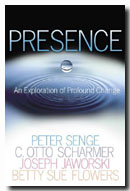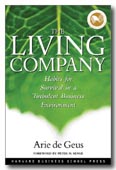Issue 18: In This Issue:
- Presence
- The Living Company
Presence
By Peter Senge, C.Otto Scharmer, Joseph Jaworski & Betty Sue Flowers 
Presence is an unusual business book in a number of ways. Although it deals with important topics in today's business environment, 'change' and 'learning', it's not just any run-of-the-mill-get-your-employees-in-tune-with-the-new-structure change. It is profound, transformational change in people, organizations and society.
Not a Recipe Book
And finally, the authors don't provide a tidy step-by-step how-to guide as is the norm for many business books today. There is no recipe here. Rather, Presence provides a perspective, an approach or an awareness that you can leverage in a variety of ways in your own particular situation.
The Whole in the Parts
The title of the book, 'Presence', is the result of a concept borrowed from the natural world, in which the whole is entirely present in any of its parts. The authors argue that too often we remain stuck in old patterns of seeing and acting and propose that by developing deeper levels of learning , we create an awareness of the larger whole, leading to actions that can help to shape it's evolution and our future.
A central theme running through the entire book is a focus on understanding the nature of wholes, and how parts and wholes are interrelated. The authors maintain that our normal way of thinking cheats us. It leads us to think of wholes as made up of many parts, the way a car is made up of wheels, chassis, engine and drive train. In this way of thinking, the whole is assembled from the parts and depends upon them to work effectively. If a part is broken, it must be repaired of replaced.
Machines vs Living Systems
They point out that although this is a very logical way of thinking about machines, living systems are different. Unlike machines, living systems are not mere assemblages of their parts but actually create themselves and are continually growing and changing along with their elements.
The concept that organizations are living systems has begun to be addressed in the business literature with texts such as 'The Living Company' by Arie de Geus, a pioneer of the organizational learning movement. The authors make the case that it is critical to adopt the perspective of an organization as living system if you are looking for transformational change in today's world.
Reactive Learning
Senge et al point out that, when we are in a state of fear or anxiety, our actions are most likely to revert to what is habitual and collective actions are no different. This is 'reactive learning', governed by downloading habitual ways of thinking, of continuing to see the world within the familiar categories we're comfortable with. We discount interpretations and options for action that are different from those we know and trust. At best we get better at what we have always done.
Deepening Awareness
As the authors point out, all learning integrates thinking and doing. But what differs is the depth of the awareness and the consequent source of action. If awareness never reaches beyond superficial events and current circumstances, actions will be reactions. If we penetrate more deeply to see the larger wholes that generate "what is" and our connection to this wholeness, the source and effectiveness of our actions can change dramatically. The key to the deeper levels of learning is that the larger living wholes of which we are an active part are not inherently static. When we become aware of the dynamic whole, we also become more aware of what is emerging.
The authors pose the questions: "Can living institutions learn to tap into a larger field to guide them toward what is healthy for the whole? What understanding and capacities will this require of people individually and collectively?". They state that they have come to believe that the core capacity needed to access the field of the future is presence.
Presence
Over the course of their conversations, the authors thought of presence as:
- Being fully conscious and aware in the present moment
- Deep listening, of being open beyond one's preconceptions and historical ways of making sense
- Letting go of old identities and the need to control and making choices to serve the evolution of life
Ultimately they came to see all of these aspects of presence as leading to a state of 'letting come", of consciously participating in a larger field for change.
When this happens they posit that the field shifts and the forces shaping a situation can move from re-creating the past to manifesting or realizing an emerging future.
The first three parts of the book correspond to the process of deepening collective learning as the authors have come to understand it. This starts with learning to see, moves on to opening to a new awareness of what is emerging and the individual's part in it, and finally leads to action that spontaneously serves and is supported by the evolving whole. The fourth and final section places this deeper learning in the context of a more integrative science, spirituality and practice of leadership.
The U Movement
The authors bring all of their thinking together in the final section of the book in a model that they term the 'Seven Capacities of the U Movement".
Going down one side of the U you have 'Suspending', 'Redirecting' and 'Letting go'. At the bottom of the U is 'Letting come' or Presencing. Then ascending the far side of the U is 'Crystallizing', 'Prototyping' and finally 'Institutionalizing'.
Concepts Worth Considering
The experience of difficulty, and even failure, in change management initiatives is a common one for many business leaders - even for run-of-the-mill-get-your-employees-in-tune-with-the-new-structure change, never mind transformational change.
Could it be that in these initiatives we are not taking the perspective of organizations as living systems? That we are not seeing the whole present in the parts that we are trying to change?
Presence is an interesting read and provides lots of grist for the mill in answering these and many other questions regarding organizational learning and change.
To purchase 'Presence' click this link to get it from: 
The Living Company
By Arie de Geus 
In 'The Living Company', Arie de Geus argues that there is accumulating evidence that corporations fail because the prevailing thinking and language of management are too narrowly based on the prevailing thinking and language of economics.
Companies Die Because …
To put it another way: Companies die because their managers focus on the economic activity of producing goods and services and they forget that their organizations' true nature is that of a community of humans.
The emphasis on profits and on the maximization of shareholder value ignores the two most significant forces acting on companies today - the shift to knowledge as the critical production factor and the changing world around companies.
Coping With Change through Learning
To cope with a changing world, any entity must develop the capability of shifting and changing, of developing new skills and attitudes - in short, the capability of learning. The essence of learning is the ability to manage change by changing yourself. A successful company is one that can learn effectively.
De Geus maintains that the sharp difference between these two definitions-the economic company definition and the learning company definition- lies at the core of the crisis managers face today. And he further states that the tension between them is almost certainly one of the key reasons behind the surprisingly low average life expectancy of companies in the northern hemisphere. For instance, a full one-third of the companies listed in the 1970 Fortune 500 had vanished by 1983-acquired, merged, or broken into pieces.
The Company as a Living Organism
De Geus invokes the metaphor of a company as a living organism. Like all organisms, the author maintains, the living company exists primarily for its own survival and improvement - to fulfill its potential and to become as great as it can be. It does not exist solely to provide customers with goods, or to return investment of shareholders.
He also utilizes another metaphor by comparing an economic company to a puddle of rainwater—a collection of raindrops, gathered together in a cavity or hollow. These drops are the puddle and most puddles have very short lifespans like the economic company.
He then extends the metaphor to the living company by comparing it to a river. Unlike a puddle, a river is a permanent feature of its landscape. Come rain, the river may swell. Come shine, the river may shrink. But it takes a long and severe drought for the river to disappear. A company, by initiating rules for continuity and motion of its people, can emulate the longevity and power of the river.
4 Key Elements to Organizational Survival
The author explores the theme of organizational learning and identifies four key elements to organizational survival and renewal: sensitivity to the environment (a company's ability to learn and adapt), cohesion and identity (a company's innate ability to create a community and a persona), tolerance (the ability to build constructive relationships with other entities), and conservative financing (the ability of a firm to govern its growth and evolution). Together, these four factors are essential to growth and viability.
Continuous Management for Change
Continuous, fundamental changes in the external world result in a turbulent business environment and require continuous management for change in the company. This means making continuous fundamental changes in the internal structures of the organization and, for many psychologists, this principle represents one important aspect of learning.
De Geus points out that this imperative also has important consequences for the way we run our companies. The company must be able, when necessary, to alter its marketing, its product range, where and how it does its manufacturing, and its organizational form-to stay in harmony with the surrounding world.
Transformational Change
This degree of change would readily be considered profound and transformational. And for this reason 'The Living Company' is an excellent companion read to Senge et al's 'Presence' (see review elsewhere in this newsletter).
To purchase 'The Living Company' click this link to get it from: 